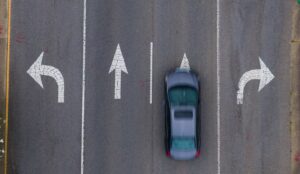In the first of a two-part conversation with Mike Potts, CEO of StreetDrone, he lends us his thoughts on the outlook for post-Covid autonomous mobility – better, worse or just different?

Q – Mike, of course there are far more pressing issues out there at the moment than autonomous mobility, but how do you think the experience of lockdown around the world will influence the progress of the sector when the world gets back to normal?
Mike Potts: Firstly, can I say that our thoughts are with all those having a tough time right now. At StreetDrone, we’re lucky in that it’s pretty much business as usual as we’re set up for remote working, but it must be incredibly tough for those businesses and families that are suffering because of the pandemic, and worried about their future.
There are a couple of aspects of the lockdown that could perhaps have a lasting effect, on top of what I hope will be a move towards more remote working generally.
The first is that a move towards the ‘virtual’ seems inevitable. For our industry, one that is mainly involved in the development and testing of autonomous technologies, that means more work using simulation for testing – which I think is generally a good thing. Of course simulation can’t replace real-world testing, but it seems hard to imagine that real-world testing of autonomous vehicles, where it is a requirement to have a safety driver and software engineer together in the vehicle, is going to be possible in the near term.
The second aspect is that contactless deliveries and services are going to be a real challenge in the months and perhaps even in the years ahead. Developing systems towards a zero person transaction will mean the driverless deliveries will certainly be at the forefront of autonomous technology development and we’re actively looking at ways of putting scalable autonomous delivery systems on the road and into institutions such as hospitals in the near term.

Q – So, we’re not close to deployments of these kind of vehicles yet? We often see reports of these types of vehicles doing jobs don’t we?
Mike Potts: Yes, it’s true that there are some services emerging, however if you actually dive into the reality these are all test vehicles, and mostly operate with either safety drivers, or with remote drivers. I think it’s true that it is easy to be seduced by the technology narrative – the media will pick up on a development that looks futuristic and that makes a good headline, and suddenly everyone assumes the capability exists for robots to pop round to the house with something ordered online 5 minutes ago. The reality is that there is no short term commercial viability to any of these services, they are all heavily subsidised with investor money or funding of some kind, so we must be wary. And that learning could not be more applicable than in the instance of autonomous cars.
Q – Explain what you mean, Mike – are autonomous cars an example of overstated technology and limited applicability?
Mike Potts: Yes and no. Autonomous vehicles, driverless cars or vans, however you want to refer to them are real, in that the technology exists for their use in specific situations or environments, but the approach to realising their benefits – for instance, talking up the clear safety gains or as a means of reduced pollution in the cities – doesn’t tell the full story.Let’s say you run a taxi company and you’re interested in running a number of autonomous cars. You first have a number of regulatory and legal issues to get over, and it’s clear that no-one has really cracked the technology fully yet, but even beyond this you’ve still got a big issue that needs to be addressed – and that’s the issue of cost.
A normal car costs £30,000 and a driver £50,000 a year, and those costs make running that car as a taxi profitable. Well, at a very basic level you’ve got to be able to match those capital and operational costs in your autonomous taxi service in order to make the switch. Sure there are some service benefits, including the reduction of person-to-person contact in a driverless vehicle, but also no-one to disinfect the vehicle either!The reality is that, at the moment, the autonomous vehicle alternative will cost you at least £300,000, and likely a lot more. That includes the vehicle, all the safety aspects that are needed to run a vehicle without a driver, the sensors including additional cameras, LiDAR and RADAR and a set of computers.
Then you need to add either the licence cost and support for the software, if you can actually buy that software or build the software yourself. The numbers on this cost aren’t clear, however Google have apparently spent north of $3bn on this challenge and have 600-ish vehicles running, most of which still have a safety driver, so we’re looking at a cost per vehicle of $5m without even taking into account the PhD-level engineer that is currently having to replace the driver. It doesn’t add up does it!Of course there are a lot of variables here and my example is way too simple to make a point, but it’s clear that the tougher the technology challenge is, the more expensive the kit is, whether just the car or indeed the software. It’s for that reason that we think that slow moving autonomous services are most likely to commercialise first, and that seems to be the case where there are already autonomous services, for instance on farms and in mines. Basically the slower you make the vehicles, the easier the tech challenge becomes and the quicker you can remove the safety driver from the system. Think autonomous road sweeper, medical deliveries, refuse collection and private & public urban shuttles.
But the biggest challenge might still be safety and convincing authorities and the public that all this is safe, COVID-19 or not.
Q – Okay, that makes sense. So why is it such a problem to take the safety driver out. We put a man on the moon decades ago?
Mike Potts: Well, there’s a couple of reasons, but the main one is that we are framing the problem incorrectly. It feels like both the mass market vehicle manufacturers and “new economy” autonomous providers still want to own the end-to-end solution when it comes to most vehicles, and that commercial imperative is skewing the objectives we are setting.
For instance, the robotaxi parameters being pursued by Waymo, Navya, Optimus and the like are high speed vehicles being tested at 60, 70 or 80kph. This speed makes the technical problem to safely manage a vehicle operating autonomously much much larger than a road-sweeper travelling at 20 kph.These operators are also aiming to defeat the endless environment permutations that grow as you move across zones – from the city centre, to suburbs, to rural and long distance driving. Each zone has its own particular set of attributes that have to be accounted for in the operating parameters of the vehicle – we term this the Operational Design Domain. Compound the high speeds with the infinite ODDs together and you end up with an almost limitless and open-ended problem that will be both time-consuming and incredibly expensive to solve. Not only does this limit the potential to see solutions coming to market anytime soon, but it also means that they have questionable commercial viability.

Q – Well, what about the car makers rather than the robotaxi companies? Are they not throwing their not inconsiderable weight behind driverless solutions?
Mike Potts: Just this week, Audi abandoned its Level 3, eyes-off autonomous driving technology. Tesla’s Autopilot and GM’s Autocruise are pegged at Level 2 autonomy. And there’s a pattern here. All of the solutions, limited in scope as they are, feature on $80,000+ cars.
What this belies is that the OEMs are attacking the solution from the same standpoint that underpins their traditional car business. They want to sell you something shiny that you aspire to have on your driveway. But the market for super-expensive, privately owned autonomous cars will be small, very small and I’d speculate, not worth the development costs for the car manufacturers. They are missing the point and simply trying to do what they’ve done since the Model T and tilt their offer towards private ownership. I just don’t see the market for an autonomous, privately owned $80,000 car that is restricted to 20mph in cities.

So slow-speed urban autonomy will not be about private ownership, it will be about better service levels and fleet ownership. We believe that the traditional vehicle manufacturers will continue to exist long in the future, but their technology will be ultimately limited to ever advancing driver assistance systems , under the control of their human operators, because the investment to make these cars drive themselves in all scenes and scenarios won’t ever make economic sense. It’s also informative to look at consumer trust and confidence in autonomous cars. The JD Power Mobility Confidence Index in Q1 2020 says 67% of US consumers don’t believe that autonomous technology is ready. That may not be particularly surprising, but what is rather more jarring is the report’s insight that car makers are pushing forward with technology that consumers seem to have little interest in.
Q – So what’s the solution?
Mike Potts: There are a few considerations, First off, however, we have to get the safety driver out of the vehicle in order to live up to our name, and that doesn’t mean creating more situations where the driver is needed to operate as a safety engineer. To take this first, essential step, we need to slow everything down. But bear in mind, even a low speed autonomous shuttle moving at 20mph would half the average journey time when compared to a conventional car commuting in London or Washington.
By reducing speeds to 20mph, at a stroke we reduce the complexity of the problem. In the near future we can imagine that the shuttle no longer needs to bristle with hundreds of thousands of dollars of sensors. We simplify the question being asked so the solution starts to come into range. Then we focus on limited use cases – we don’t aim to provide an autonomy-for-all solution and somehow imagine we can swap a traditional car that right now is happily driven through endless different contexts into an intelligent and pilotless solution overnight. We take it a step at a time. In terms of choosing the use case, it then becomes self-evident that slow speed suits cities best. No-one would tolerate travelling at 20mph on a long, rural journey. But in a city, when you are doubling the average speed of a regular car or bus, it would represent progress. And of course, cities are where the productivity losses due to congestion are highest and where the air quality due to pollution is the lowest.

Q – So, to summarise, Mike, we need to slow down, focus on specific ODDs and focus on removing the safety driver from the equation – and that will gives autonomous mobility the prompt it needs to prosper in the post-Covid 19 landscape?
Mike Potts: I think that’s a very large part of the answer and very much the essential first steps. We have another significant contribution to getting slow speed, urban mobility moving – more about that in next week’s post.
For more information on slow speed, urban autonomy, please do get in touch at Info@streetdrone.com




